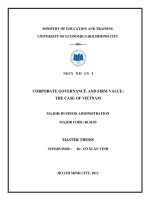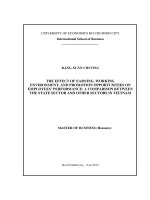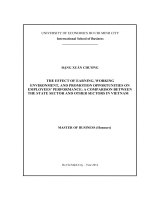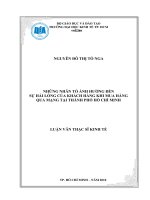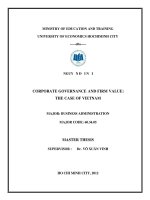Measure the interest rate risk Acase study of Vietcombank Luận văn thạc sĩ
Bạn đang xem bản rút gọn của tài liệu. Xem và tải ngay bản đầy đủ của tài liệu tại đây (2.44 MB, 86 trang )
i
MINISTRY OF EDUCATION AND TRAINING
UNIVERSITY OF ECONOMICS HO CHI MINH CITY
PHAM THI XUAN LIEN
MEASURE THE INTEREST RATE RISK:
A CASE STUDY OF VIETCOMBANK
ECONOMICS MASTER THESIS
HOCHIMINH CITY, 2010
ii
MINISTRY OF EDUCATION AND TRAINING
UNIVERSITY OF ECONOMICS HO CHI MINH CITY
PHAM THI XUAN LIEN
MEASURE THE INTEREST RATE RISK:
A CASE STUDY OF VIETCOMBANK
Major: Financial and Banking
Major Code: 60.31.12
ECONOMICS MASTER THESIS
Supervisor: Dr. Le Thai Thuong Quan
HOCHIMINH CITY, 2010
iii
A
A
C
C
K
K
N
N
O
O
W
W
L
L
E
E
D
D
G
G
E
E
M
M
E
E
N
N
T
T
I would like to express my honest gratitude to my devoted research Supervisor, Dr.
Le Thai Thuong Quan, for his assistance and valuable guidance during the course of
fulfillment this thesis.
I would like to thank my colleagues from Vietcombank, who have helped me in
collecting data for this thesis: Ms. Nguyen Thi Minh Trang from An Giang Branch,
Ms. Le Mai Trinh from Dong Thap Branch. Especially, I would like to express my
sincere thanks to Ms. Ho Thi Bich Lien – chief accountant of An giang Branch for
her recommendation to Ms. Phung Nguyen Hai Yen, Deputy Director of Finance
and Accounting Department in Vietcombank head office.
I would like to avail this opportunity to express my appreciation to Professor
Nguyen Dong Phong, UEH Board of Director for conceiving the Banking Master
Program in English. I also would like to express my sincere gratitude to all mu
teachers at Post-graduate Faculty- University of Economics Hochiminh City for
their teaching and guidance during my Master in Banking course.
Finally, I would like to extend my deepest gratitude to my beloved family, special
thanks to my husband, Pham Trung Khanh, my son, Tony for their endless love and
great support during study period.
iv
A
A
B
B
S
S
T
T
R
R
A
A
C
C
T
T
With the volatility in the interest rate recent years, the interest rate more
becomes a vital problem of Vietnamese bankers. Fluctuations in the interest rate
since 2008 that effected sharply to the bank‟s interest income and value, making
interest rate risk management decisive to its success. It is necessary to call for high
degree in the asset and liability management with the duty of managing the bank‟s
interest rate risk exposure through the use of various hedging strategies and
instruments as well as balance sheet adjustment.
This qualitative research measures the interest rate risk in Vietcombank - the
leader in interest rate maker in domestic banks by using the gap model (dollar gap)
also referred to as the funding gap or the maturity gap. The research shall investigate
the movement of the Vietnam interest rate in financial market since 2008. Then it
will analyze the gap (dollar gap) in Vietcombank financial statement to measure the
interest rate risk that affected to the income of the bank. Finally, there shall be some
suggested solutions in improve the gap as well as the net interest income.
Keywords: Gap, Gap analysis, interest rate, interest rate risk, interest rate risk measurement,
asset and liability management, Vietcombank, financial statement, SBV, VNIBOR.
v
CONTENTS
Acknowledgement
Abstract
Contents
List of Tables
List of Figures
Abbreviations
Chapter 1: INTRODUCTION
1.1 Background, context and rationale for the research 1
1.2 Why is the problem worth addressing? 2
1.3 Objectives/goals of the research 3
1.4 Methodology 4
1.5 Data analysis and finding 5
1.6 Study structure 5
Chapter 2: THEORY OF INTEREST RATE RISK AND
INTEREST RATE RISK MEASUREMENT
2.1 Background 6
2.2 Risks assumed by banks 7
2.2.1 Credit risk 7
2.2.2 Interest rate risk 8
2.2.3 Operational risk 8
2.2.4 Liquidity risk 9
2.2.5 Price risk 9
vi
2.2.6 Compliance risk 9
2.2.7 Foreign Exchange risk 9
2.2.8 Strategic risk 10
2.2.9 Reputation risk 10
2.3 Interest rate risk 10
2.4 The model of measuring the interest rate risk 12
2.4.1 Definition 14
2.4.2 Calculation 14
2.4.3 Limitation of gap model 17
2.5 Interest rate risk management 18
2.5.1 On balance sheet adjustment 18
2.5.2 Off balance sheet adjustment 19
2.5.2.1 Using interest rate futures to hedge a dollar gap position 19
2.5.2.2 Using forward contract 20
2.5.2.3 Using option contract 21
2.5.2.4 Using interest rate swap 22
2.6 Manage interest rate risk with dollar gap 24
2.6.1 Aggressive management 25
2.6.2 Defensive management 25
2.7 Conclusion 25
Chapter 3:
I
I
N
N
T
T
E
E
R
R
E
E
S
S
T
T
R
R
A
A
T
T
E
E
M
M
O
O
V
V
E
E
M
M
E
E
N
N
T
T
I
I
N
N
V
V
I
I
E
E
T
T
N
N
A
A
M
M
A
A
N
N
D
D
V
V
I
I
T
T
E
E
C
C
O
O
M
M
B
B
A
A
N
N
K
K
I
I
N
N
T
T
E
E
R
R
E
E
S
S
T
T
R
R
A
A
T
T
E
E
P
P
O
O
L
L
I
I
C
C
Y
Y
3.1 The movement interest rate in Vietnam 27
3.1.1 Interest rate before the Renovation Policy 27
3.1.2 Interest rate after the Renovation Policy 28
3.1.3 Interest rate volatility period 29
vii
3.2 Interest rate policy in Vietcombank 31
3.2.1 Background 31
3.2.2 Interest rate policy 32
3.2.3 The fluctuation in 2008 34
3.2.4 The fluctuation in 2009 36
3.2.5 The movement in first six month of 2010 37
3.3 Conclusion 38
Chapter 4: MEASURE THE INTEREST RATE RISK IN THE
COMMERCIAL JOINT STOCK BANK FOR FOREIGN
TRADE OF VIETNAM (VIETCOMBANK)
4.1 Introduction. 39
4.2 Research design 40
4.2.1 Data collection and analysis 41
4.2.2 Personal interview 42
4.3 Interest rate risk exposure 42
4.4 Balance sheet structure 45
4.5 Gap Analysis 47
4.6 Conclusion 54
Chapter 5: Suggest and conclusion
5.1 Conclusion 56
5.2 Conclusion related to search questions 57
5.3 Suggest for hedgeing the gap 59
5.3.1 Balance sheet adjustment 59
viii
5.3.2 Off – balance sheet 60
5.4 Limitation of the research and suggest for further research 63
References
Appendix
ix
ABBREVIATIONS
ALM
Asset and Liability Management
ALCO
Asset and Liability Committee
VCB
The Bank for Foreign Trade of Vietnam
SBV
The State Bank of Vietnam
SOCBS
State Owned Commercial Bank
RSA
Rate Sensitivity Asset
RSC
Rate Sensitivity Viability
FS
Financial Statement
SMEs
Small and Medium Enterprises
NRS
Non Rate Sensitivity
VND
Vietnam Dong
VAS
Vietnamese Accounting Standard
BOM
Board of Management
x
L
L
I
I
S
S
T
T
O
O
F
F
T
T
A
A
B
B
L
L
E
E
S
S
Table 2.1 Exposure to interest rate
Table 2.2 Classification of Assets and Liabilities by interest rate sensitivity
Table 2.3 The relation in Gap, Interest rate changes and net interest income
Table 2.4 Distinction incremental gap and cumulative gap
Table 4.1 VCB balance sheet in 2009
Table 4.2 VCB Classification of Assets and Liabilities by interest rate
sensitivity
Table 4.3 VCB Gap, Relative gap, interest sensitivity ratio
Table 4.4 Maturity buckt of loans and deposits from customer at
31.12.2009
Table 4.5 VCB Reprcing mismatch in 2008, 2009 and first six months in
2010
Table 4.6 The compnent of net interest income in each maturity bucket
Table 4.7 The effect f changing interest rate to NII
xi
LIST OF FIGURE AND EQUATION
FIGURE
Figure 2.1 Payoff for unhedged call option
Figure 2.2 Payoff for unhedged put option
Figure 2.3 Using an interest rate swap to hedge liability and asset sensitive
position
Figure 3.1 SBV report – Credit and Deposit growth
Figure 3.2 Movement of interest rate since 2006
Figure 3.3 Interest expenses from 2005-2009 of Vietinbank, Vietcombank,
Sacombank, Eximbank and Asiabank
Figure 3.4 VCB lending and fund mobilization growth from 2001-2010
Figure 3.5 VCB movement of lending and deposit rate
Figure 3.6 VCB difference between interest income and interest expenses
from 2001-Jun 2010
Figure 3.7 VCB movement of lending and deposit rate in 2008
Figure 3.8 VCB movement of lending and deposit rate in 2009
Figure 3.9 VCB movement of lending and deposit rate in Jun 2010
Figure 4.1 Gaps in the period of 2002-06ms/2010
Figure 4.2 Turnover of loan and deposit from customer at 31.12.2009
Figure 4.3 The repricing mismatch in each maturity bclet from 208-
06ms/2010
Figure 4.4 The component of NII in 06ms/2010
xii
EQUATION
Equation 2.1 Gap Model
Equation 2.2 Calculation delta net interest income
Equation 2.3 Relative gap
Equation 2.4 Interest sensitivity ratio
Equation 2.5 Number of contract to hedge an asset sensitive position
- 1 -
1.1 BACKGROUND, CONTEXT AND RATIONALES FOR THE
RESEARCH
The Vietnamese financial market has rapidly expanded over the past few years and
has gained great strategic importance at the global level. With the rapid
liberalization, privatization and globalization of the market, Vietnam has become a
preferred destination of international financial investors. The key financial sectors
„banking‟ and „insurance‟ are attracting huge foreign investment as both of these
sectors represent highly untapped potential.
Thanks to the "Doi Moi" policy in the year 1986, the economy of Vietnam showed
marked improvement associated with market oriented. Improvement was also seen
in the banking sector indicated the interactive relation between financial
liberalization and economy reform. The proof of this innovation is the dramatic
decline in inflation in 1988 (700 percent) to 67 percent in 1990, and it has continued
to decline though 1994. Moreover, the banking system was gradually improved and
became more effective intermediation of financial resources. Banking sectors has a
significant contribution in fund mobilization serving manufacture, economy
stimulus and the core channel of socio-economic capital. They are in charge of
mobilization the idle resources from population and credit fund to demanded
economic sectors to boost the priority tasks of modernization and industrialization.
The General council of World Trade Organization approved Vietnam‟s membership
on 7 November 2006, and Vietnam became the WTO‟s 150th member. After joining
the WTO, the State Bank of Vietnam has continued its efforts to perfect its legal
regulations in conformity with international commitments and Vietnam's situation.
Many legal documents have been issued to facilitate banking activities in Vietnam.
- 2 -
The central bank have also taken initiative in implementing measures to develop the
monetary, foreign currency market, strengthen its capacity in implementing
monetary and foreign exchange policies, carry out administrative reforms, expand
international co-operation to exchange and learn more experiences.
However, the global financial crisis has impacted to the economy associated with
some risks in domestic financial environment. The recent volatility in the VNIBOR
rate appears to be liquidity story of domestic bankers. Bankers are in the war of fund
mobilization by offer a negotiable interest rate and lending it with higher rate. The
interest rate risk management in Vietnam bankers are became vital banking
activities.
Risk management is defined by Dickson (1989: 18) in Valsamakis et al (1992: 13)
as “the identification, analysis and economic control of those risks which threaten
the assets or earning capacity of an organization.” As such the management of risk
has, explicitly or implicitly, become part of a strategic component of the modern
organization‟s survival and development (Waring and Glendon, 1983:3).
Bernstein (1998) in De la Rosa (2003: 55) identifies that the principals of modern
risk management were first established in the 1600s when mathematical concepts
were first used in games of chance. Twentieth century authors such as Knight
(1921) and Keynes (1921) provided noteworthy insight into the development of
uncertainty, probability and the law of large numbers-concepts which today
underpin risk management.
So, bankers make decisions every day about funding deposit, about whether to make
particular loans and about how to fund their investment and lending activities. These
- 3 -
decisions are based, in part on their outlook for interest rates, the composition of
their assets and liabilities and the degree of risk that they are willing to take.
Collectively, these decisions affect the bank‟s net interest income and balance sheet
values. The process of making such decisions about the composition of assets and
liabilities and the risk assessment is known as asset/liability management (ALM).
The decisions are usually made by the asset/liability management committee
(ALCO) that is responsible for the overall financial direction of the bank.
1.2 WHY IS THE PROBLEM WORTH ADDRESSING?
As one of the biggest well-known bank in Vietnam, the research will provide a
range of alternatives which Vietcombank can incorporate into its interest rate risk
management strategy. The practicality of interest rate risk measurement model will
be applied in the chaos specified period and specific business circumstance, its
interest rate risk position and market conditions over the specified period.
Furthermore, the thesis will analyze the component of the net interest income
matched to the maturity bucket of Vietcombank asset and liability.
Recommendations will be provided on the basis of a theoretical asset and liability
structure which may further aid the Vietcombank in its management interest rate
risk.
1.3 OBJECTIVES AND GOALS OF THE RESEARCH
The objective of this thesis is to
- 4 -
1. To investigate the movement of the interest rate in financial market
since 2008
2. To analyse the Vietcombank specific business practices and its interest
rate risk exposure
3. To analyse the gap in Vietcombank financial statement to measure the
interest rate risk that affected to the income of the bank.
4. And also to find out the component of net interest income according to
the maturity bucket.
The thesis will focus on identify the impact of gap to the bank‟s net interest income
and the component of the interest income/expenses according to the maturity bucket
which is closely to the asset and liability sensitivity. There will be some main
questions to answer in this study:
1. What are theoretically bank practices and/or solutions to deal with interest
rate riks?
2. What is the extent of interest rate risk in Vietcombank? Whether or not such
risk affect to its profit?
1.4 METHODOLOGY
The research methodology of the thesis is a case study. The case study method
allows for both the generating and the testing of hypotheses and allows the
researcher to identify and include certain elements, conditions and information that
may be unique to individuals and organizations, thus permitting a more holistic
study (Tellis, 1997; Kennedy and Luzar, 1999).
- 5 -
Robert K.Yin, 2005 recognises the case study methodology as “an empirical inquiry
that investigates a contemporary phenomenon within its real life context, when the
boundaries between phenomenon and the context are not clearly evident, and in
which multiple sources of evidence are used. It is particularly valuable in answering
who, why and how questions in management research”.
The thesis requires intimate knowledge of the Vietcombank business practices, legal
requirements and unique balance sheet structure, all of which provide the rationale
for the use of a case study methodology. In order to conduct a thorough analysis, a
number of practices specific to the case study methodology must be used. More
specifically, the researcher will have access to public Vietcombank achievement
records, historical Vietcombank balance sheet structures and interviews with
Vietcombank senior management. The researcher also conducts interviews with a
number of other branches in the whole system of Vietcombank in order to generate
hypotheses for the practicality of certain interest rate managing techniques.
1.5 DATA ANALYSIS AND FINDING
The study is mainly used books, scientific articles and statistic to get better
understanding of Asset and Liability Management. The data will be collected from
Annual Vietcombank‟s financial statement since the interest rate has become
volatility in 2008. Besides of that, questionnaires were designed and directly asked
to interviewees to collect data related to VCB‟s assets and liabilities management.
The findings are not just to help measuring the interest rate risk of Vietcombank but
also to show some difficulties as well as the strength of a SOCB in financial market.
- 6 -
On the other hands, the findings will be an evidence to manage the interest rate risk
aggressively in Vietcombank.
1.6 STUDY STRUCTURE
The thesis shall be included five chapters which chapter one involved the theory of
the research background, and presents definitions of terms, significance and scope
of the study. The chapter two shall present the theory of interest rate risk
measurement as well as the management. Chapter three shall introduce the interest
rate movement in Vietnam and Vietcombank interest rate policy. Chapters four shall
analysis the gap in interest rate risk measurement and finally, the chapter five will
suggest some solution to manage to interest rate risk as well as improve the net
interest income
- 7 -
2.1 Background
For many centuries, banks have played a vital role in the financial system. That vital
role continues today although the forms of banking have changes with the needs of
the economy. Commercial banks play an important role in the financial system and
the economy. As a key component of the financial system, banks allocate funds
from savers to borrowers in an efficient manner. They provide specialized financial
services, which reduce the cost of obtaining information about both savings and
borrowing opportunities. These financial services help to make the overall economy
more efficient.
Banks can be described as intermediaries between lenders and borrowers. For
competitive reasons, bank may be obliged to accept client funds with varying
maturities that could potentially alter the structure of the balance sheet to an interest
rate sensitive position (UBS, 1987:37).
Banks tend to lend long and borrow short. This natural exposure of banks looks
beneficial when long term interest rates than are above short term interest rates.
Often, bank effectively lend at higher rates then the cost of their debts, because of
positive spread between long terms rates and short terms rate.
Besides of the traditional business in deposit and loan, nowadays bank may have
developed some other functions:
Paying a customer's cheques or drafts on it to the amount on deposit by such
customers, and holding Treasury Bills and bank notes and coin for such
purpose;
- 8 -
Discounting commercial paper for its customers;
Dealing in exchange and in gold and other financial instrument;
Arranging credits for itself with banks in other towns, cities and countries;
Selling its drafts or cheques on other banks and banking correspondents;
Issuing letters of credit; bank guarantees,…
Lending money to its customers on the customers' notes, by way of overdraft
(or) on bonds, shares and other securities.
Make other banking services such as: transfer money, issuing credit cards
and supply other banking services.
2.2 Risks assumed by banks
According to Bessis (2002), there are a large number of risks in the banking
industry, of which most are well known. Risk and the management of it are
important to banking and with this in mind it is somewhat surprising that risk
quantification remained limited until recently. Risk management requires an entire
set of models and tools for linking risk management issues with financial views on
risks and profitability (Ibid). This is supported by Galai et al (1999) who state that
the recent financial failures in the banking industry confirm the need for various
form of risk management. Therefore managers of banks need reliable risk measures
in order to be able to direct capital to activities with the best trade off between risk
and return. Risk management is the process of identifying key risks, acquiring
understandable risk measures, choosing which risk to reduce and which to increase
and by what means, and finally ascertaining procedures to monitor the resulting risk
position (Galai et al 1999).
- 9 -
According to Gup & Kolari (2005), banking is the management of risk; banks
accept risk in order to earn profits. They must balance alternative strategies in terms
of their risk/return characteristics with the goal of maximizing shareholder wealth.
In doing so, banks recognize that there are different type of risk that the impact of
particular investment strategy on shareholders depend on the impact on the total risk
of the organization. These risks are stipulated as follows:
2.2.1 Credit risk
Credit risk is one of the earliest risks recognized in banking. Credit risk is the risk to
earnings and capital that an obligor may fail to meet the terms of any contract with
the bank. It is usually associated with loans and investment, but it can also arise in
connection with derivatives, foreign exchange and other extension of bank credit.
Although bank fails for many reasons, the single most important reason is bad loan.
Of course, bank don‟t make “bad” loans, they make loan that go bad.
At the time the loans were made the decisions seemed correct. However, unforeseen
changes in economic conditions, and other factors such as interest rate shocks,
changes in tax laws, and so on, have resulted in credit problems. Credit risk is the
primary cause of bank failures, and it is the most visible risk facing the bank
managers.
2.2.2 Interest rate risk
Interest rate risk is the risk to earnings and capital that market rates of interest may
change unfavorably. This risk arises from differences in timing of rate changes and
the timing of cash flows (repricing risk), from change of the shape of the yield curve
(yield curve risk) and from option values embedded in bank products (option risk).
In essence, the market value of a bank‟s assets (i.e.,loan and securities) will fall with
- 10 -
increases in interest rates. In addition, earning from assets, fee, and the cost
borrowed funds are affected by changes in interest rates. Bank can reduce their
interest rate risk by hedging worth derivatives securities and by using the
asset/liability management techniques.
2.2.3 Operational risk
Operational risk (also referred to as transaction risk) is the risk to earnings or capital
arising from problems associated with the delivery or service of a product.
Operational risk encompassed the efficiency and effectiveness of all back-office
operations including management information systems, personnel, compliance,
external and internal frauds, lawsuits and so on.
2.2.4 Liquidity risk
Liquidity risk is the risk to earnings or capital related to a bank‟s ability to meet its
obligations to depositors and the needs of borrowers by turning assets into cash
quickly with minimal loss, being able to borrow funds when needed, and having
funds available to execute profitable securities trading activities. Given the large
amount of bank deposits that must be paid on demand or within a very short period,
liquidity risk is of crucial importance in banking.
2.2.5 Price risk
Price risk is the risk to earning or capital related to market-making, dealing, or
taking positions in securities, derivatives, foreign exchange, or other financial
instruments. For example, as a result of financial crisis in Asia in 1998, several large
- 11 -
banks (including Bankers Trust, Bank America and Citicorp) suffered losses in their
foreign exchange and derivatives positions.
2.2.6 Compliance risk
Compliance risk is the risk to earnings or capital arising from violations of laws,
rules, regulations, and so on. For example, banks failing to meet minimum capital
requirements must raise new capital, or they may be closed, forced to merge or
required to take some other corrective action.
2.2.7 Foreign Exchange risk
Foreign exchange risk is the risk to earnings or capital due to changes in foreign
exchange rates.
2.2.8 Strategic Risk
Strategic risk is the risk to earnings or capital arising from making bad business
decisions that adversely affects the value of the bank.
2.2.9 Reputation risk
Reputation risk is the risk to earnings or capital arising from negative public opinion
of the bank. Negative public opinion can arise from poor service, failure to serve the
credit needs of their communities, and for other reasons. Regulators feared that
negative public opinion would contribute to a loss of market share and be potential
source litigation.
- 12 -
2.3 Interest rate risk
Interest rate risk is regarded by a number of authors such as Heffernen (1996),
Bessis (2002) and Sinkey (2002) as one of the most prominent financial risks faced
by a bank. According to Van Son & Hassan (1997) mismanagement of interest rate
risk, first manifests itself in reported earnings and, if unchecked, results in liquidity
and solvency problems. Thus, the monitoring of interest rate risk, whether through
risk-based capital requirements or a separate measure, should not be ignored by
bank managers. Furthermore Van Son & Hassan (1997) suggest that the
management of interest rate risk varies with bank size, and larger banks use more
sophisticates methods for managing interest rate risk and receive more and closer
scrutiny from the market.
Gup & Kolari (2005) defined that interest rate risk is the risk to earnings and capital
that market rates of interest may change unfavorably. This risk arises from
differences in timing of rate changes and the timing of cash flows (repricing risk),
from changes in the shape of the yield curve (yield curve risk), and from option
values embedded in bank products (option risk). In essence, the market value of a
bank‟s assets (i.e.,loans and securities) will fall with increase in interest rate. In
addition, earning from assets, fees, and the cost of borrowed funds are affected by
changes in interest rates.
Interest rate risk stems from asset and liabilities maturing at different times, and can
be encompassed in three elements, namely “the margin between the earned on assets
and paid on liabilities, the reprising potential of assets and liabilities at different
point in time, resulting in mismatches in various time bands between assets,
- 13 -
liabilities and derivates and finally, the period during which these mismatches
persist”.
Interest rate risk is the exposure of a bank's financial condition to adverse
movements in interest rates. Accepting this risk is a normal part of banking and can
be an important source of profitability and shareholder value. However, excessive
interest rate risk can pose a significant threat to a bank's earnings and capital base.
Changes in interest rates affect a bank's earnings by changing its net interest income
and the level of other interest-sensitive income and operating expenses. Changes in
interest rates also affect the underlying value of the bank's assets, liabilities and off-
balance sheet instruments because the present value of future cash flows (and in
some cases, the cash flows themselves) change when interest rates change.
Accordingly, an effective risk management process that maintains interest rate risk
within prudent levels is essential to the safety and soundness of banks.
Saunders (2000) state that interest rate risk is the risk that evolves when a bank
mismatches the maturity of its assets or liabilities. When banks hold longer term
assets relative to liabilities, it potentially exposed itself to refinancing risk. This is
the risk that the cost of rolling over reborrowing funds could be more than the return
earned on asset investments. There is also a possibility of reinvestment risk, which
is that the returns on funds to be reinvested will fall below the cost of funds. In
addition to suffering a refinancing or reinvestment risk that occurs when interest
rates change, a bank faces market value risk as well. Market value of an asset or
liability is equal to the discounted future cash flows of that asset or liability.




